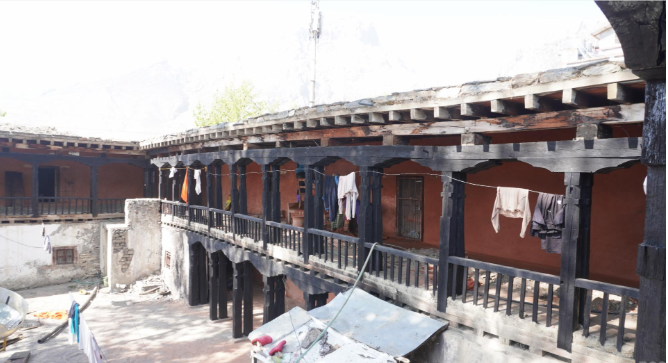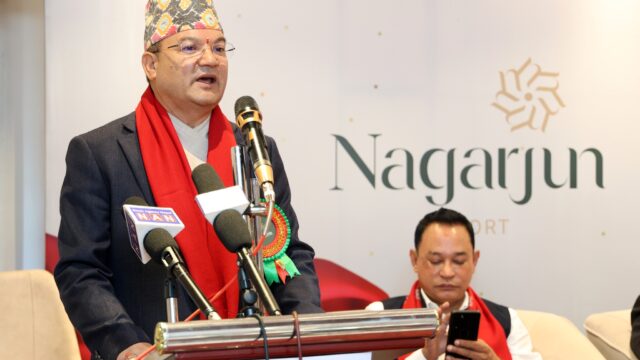A ranipauwa is vital heritage site in the heart of the Baragung Muktikshetra Rural Municipality, Ward No. 1, is undergoing much-needed restoration as efforts are underway to upgrade the 218-year-old Ranipauwa Dharamshala. Built during the Rana regime, the Dharamshala is a cornerstone of pilgrimage hospitality near the revered Muktinath Temple and has long served as a resting place for devotees and ascetics.
Constructed during the reign of King Rana Bahadur Shah by his second queen, Suvarnaprabha, the historical structure was built with the vision of providing food and shelter to pilgrims visiting the sacred Muktinath. According to Swami Bharat Koirala, who is currently responsible for the supervision and management of the Dharamshala, Queen Suvarnaprabha established the site as a symbol of devotion and benevolence towards travelers making the arduous spiritual journey to Muktinath.
Heritage Meets Purpose: A Symbol of Sacred Service
The Ranipauwa Dharamshala, named in honor of Queen Suvarnaprabha, was originally constructed in traditional Himalayan architectural style using stone and clay. The two-story structure contains 21 rooms designed to accommodate pilgrims, sadhus, and temple priests. Over time, however, the building fell into disrepair, creating difficulties for those relying on its shelter.
“The roof was leaking, and the toilet and bathroom facilities had become dilapidated,” said Swami Koirala. “These conditions caused inconvenience for devotees. Therefore, under the guidance of Jagadguru Swami Kamalnayanacharya, we initiated the restoration work.”
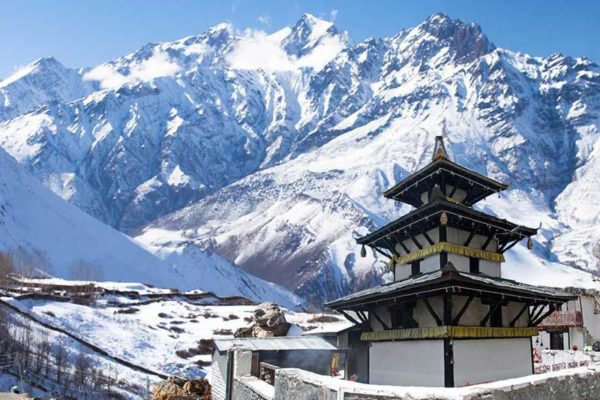
Collaborative Effort with Cultural Sensitivity
The restoration is being carried out with a joint budget of NPR 7.4 million (approximately USD 55,000), provided by the Department of Archaeology and Baragung Muktikshetra Rural Municipality. The construction team, led by contractor Ramesh Gurung, is committed to preserving the original aesthetics and traditional elements of the Dharamshala.
According to Gurung, careful consideration is being given to ensure that the original beauty of the Dharamshala is not compromised. “We are renovating the roof using wooden planks, adding bitumen for waterproofing, and applying a layer of eco-friendly plastic and clay mortar,” he explained. Additionally, the structure is undergoing repainting, surface finishing, and the repair of windows, doors, toilets, and bathrooms.
“This is not just another construction contract; it is a service of religious and cultural importance. We are more focused on maintaining quality rather than maximizing profit,” Gurung emphasized. “We aim to complete 100% of the project as per our agreement, ensuring that the sacred duty of serving Muktinath pilgrims is honored.”
A Sanctuary for Pilgrims from Near and Far
Muktinath is a significant religious destination for both Hindu and Buddhist pilgrims. It attracts thousands of devotees annually, including domestic pilgrims from Myagdi, Parbat, Syangja, and international spiritual travelers from India and beyond. The Dharamshala, with its historical and religious significance, plays a crucial role in accommodating and supporting these visitors.
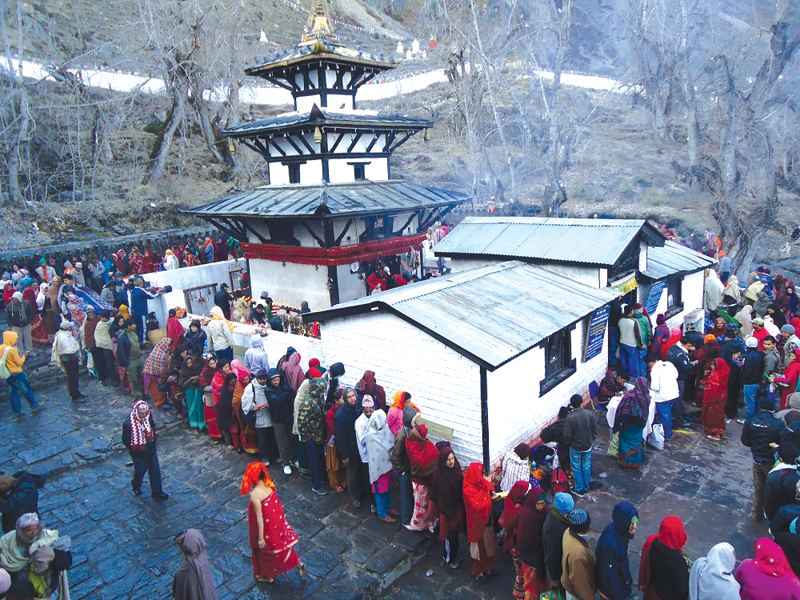
Krishna Prasad Subedi, a priest at Muktinath Temple, highlighted that Queen Suvarnaprabha had also established the “Satawarta Guthi” (a traditional endowment) for food grain production and supply to sustain temple activities and support pilgrims. “She dedicated around six ropani and twelve anna of land in the Muktinath area specifically for this Dharamshala,” said Subedi.
However, over the years, much of the guthi land in Myagdi, Parbat, and Syangja, originally dedicated to the temple and Dharamshala, has either been encroached upon or turned into private property. “Many of the individuals currently cultivating the land have stopped handing over the traditional share of the harvest for more than two decades,” Subedi added.
He explained that until 2046 B.S. (1990 AD), grain contributions from the Satawarta Guthi continued, but since then, the tradition has nearly vanished. This decline has affected the Dharamshala’s capacity to provide food to visitors.
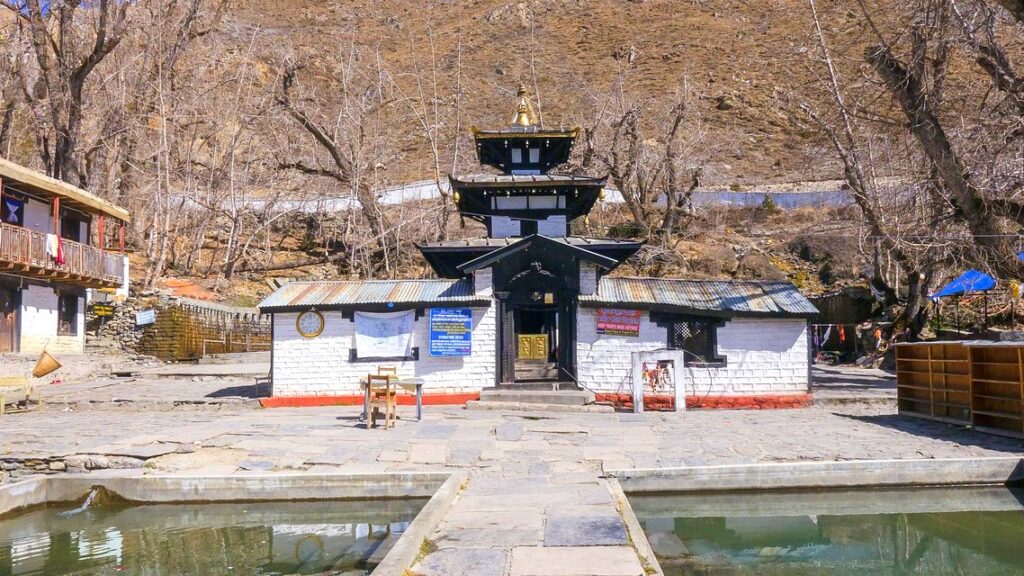
Looking Forward: Completion by End of Ashadh
According to Swami Koirala, the renovation work has been progressing for the past two weeks and is on track to be completed by the end of Ashadh (mid-July). “Currently, plastering, painting, and roofing improvements are being carried out at a rapid pace,” he shared.
The upgraded facility is expected to greatly improve living conditions for pilgrims and spiritual visitors, ensuring that they have a comfortable place to stay during their religious journey. Once completed, the renovated Ranipauwa Dharamshala will not only preserve a vital piece of Nepalese religious heritage but also continue to serve as a sacred space of hospitality, fulfilling the original vision of its royal founder.
The renovation of the Ranipauwa Dharamshala is more than a construction project, it is a revival of spiritual service, a tribute to Nepal’s cultural heritage, and a renewed commitment to the sacred hospitality that has defined Muktinath for generations. As work nears completion, the revitalized structure stands poised to welcome a new era of pilgrims, continuing its legacy of devotion and compassion.
